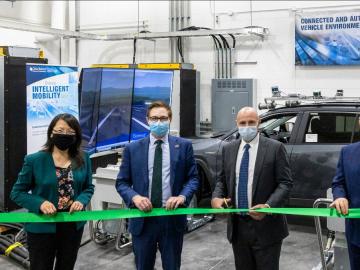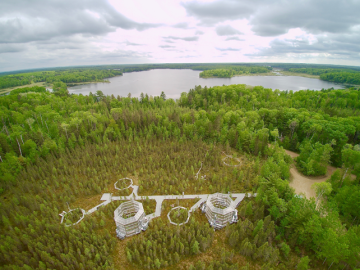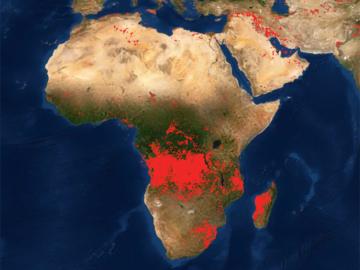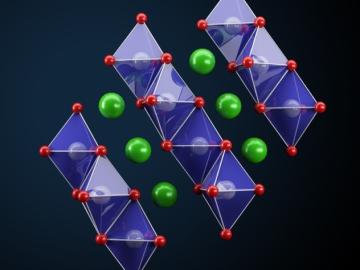
Filter News
Area of Research
- (-) Clean Energy (95)
- (-) Nuclear Science and Technology (11)
- Advanced Manufacturing (8)
- Biology and Environment (67)
- Biology and Soft Matter (1)
- Climate and Environmental Systems (2)
- Computational Engineering (1)
- Computer Science (2)
- Electricity and Smart Grid (1)
- Functional Materials for Energy (1)
- Fusion and Fission (8)
- Fusion Energy (3)
- Isotope Development and Production (1)
- Isotopes (26)
- Materials (104)
- Materials Characterization (1)
- Materials for Computing (18)
- Materials Under Extremes (1)
- Mathematics (1)
- National Security (26)
- Neutron Science (29)
- Quantum information Science (2)
- Renewable Energy (1)
- Supercomputing (65)
- Transportation Systems (2)
News Topics
- (-) Climate Change (21)
- (-) Composites (17)
- (-) Cybersecurity (9)
- (-) Decarbonization (33)
- (-) Frontier (2)
- (-) Hydropower (2)
- (-) Isotopes (6)
- (-) Materials Science (29)
- (-) Space Exploration (7)
- 3-D Printing/Advanced Manufacturing (81)
- Advanced Reactors (15)
- Artificial Intelligence (8)
- Big Data (5)
- Bioenergy (26)
- Biology (11)
- Biomedical (8)
- Biotechnology (4)
- Buildings (36)
- Chemical Sciences (14)
- Clean Water (8)
- Computer Science (27)
- Coronavirus (13)
- Critical Materials (9)
- Energy Storage (72)
- Environment (54)
- Exascale Computing (2)
- Fossil Energy (2)
- Fusion (9)
- Grid (40)
- High-Performance Computing (6)
- Machine Learning (7)
- Materials (35)
- Mathematics (2)
- Mercury (3)
- Microelectronics (1)
- Microscopy (8)
- Molten Salt (5)
- Nanotechnology (8)
- National Security (5)
- Net Zero (3)
- Neutron Science (15)
- Nuclear Energy (41)
- Partnerships (12)
- Physics (3)
- Polymers (11)
- Quantum Science (2)
- Renewable Energy (1)
- Security (6)
- Simulation (4)
- Statistics (1)
- Summit (4)
- Sustainable Energy (69)
- Transformational Challenge Reactor (5)
- Transportation (65)
Media Contacts

ORNL and Department of Energy officials dedicated the launch of two clean energy research initiatives that focus on the recycling and recovery of advanced manufacturing materials and on connected and

The combination of bioenergy with carbon capture and storage could cost-effectively sequester hundreds of millions of metric tons per year of carbon dioxide in the United States, making it a competitive solution for carbon management, according to a new analysis by ORNL scientists.

Radioactive isotopes power some of NASA’s best-known spacecraft. But predicting how radiation emitted from these isotopes might affect nearby materials is tricky

Two staff members at the Department of Energy’s Oak Ridge National Laboratory have received prestigious HENAAC and Luminary Awards from Great Minds in STEM, a nonprofit organization that focuses on promoting STEM careers in underserved

Oak Ridge National Laboratory scientists evaluating northern peatland responses to environmental change recorded extraordinary fine-root growth with increasing temperatures, indicating that this previously hidden belowground mechanism may play an important role in how carbon-rich peatlands respond to warming.

After its long journey to Mars beginning this summer, NASA’s Perseverance rover will be powered across the planet’s surface in part by plutonium produced at the Department of Energy’s Oak Ridge National Laboratory.

Scientists at Oak Ridge National Laboratory have demonstrated a direct relationship between climate warming and carbon loss in a peatland ecosystem.

Five researchers at the Department of Energy’s Oak Ridge National Laboratory have been named ORNL Corporate Fellows in recognition of significant career accomplishments and continued leadership in their scientific fields.

Researchers at Oak Ridge National Laboratory developed a method that uses machine learning to predict seasonal fire risk in Africa, where half of the world’s wildfire-related carbon emissions originate.

Oak Ridge National Laboratory scientists seeking the source of charge loss in lithium-ion batteries demonstrated that coupling a thin-film cathode with a solid electrolyte is a rapid way to determine the root cause.


